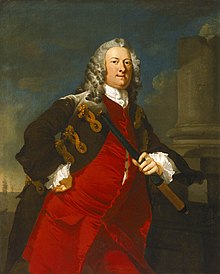Thomas Smith (Royal Navy officer)
| Thomas Smith | |
|---|---|

Portrait by Richard Wilson
|
|
| Born | 1707 |
| Died | 28 August 1762 (aged 54–55) |
| Allegiance |
|
| Service/branch |
|
| Rank | Admiral |
Thomas Smith (1707 - 28 August 1762) was a British admiral and colonial governor, credited with the invention of the divisional system that remains in use on ships of the Royal Navy.
Born in England around 1707, Smith was the illegitimate son of Sir Thomas Lyttelton and a woman of whom details are unknown. He was raised a member of the Lyttelton family, who provided for Smith's education and aided him in the beginnings of his career in the Royal Navy.
The precise date as to when Smith entered the Royal Navy is unknown, but his first notable appointment in the Service was to the position of junior lieutenant aboard the Royal Oak on 6 February 1728, at the appointment of his commanding officer Sir Charles Wager. In June of the same year he was moved to the 44-gun Gosport under the command of Captain Duncombe Drake.
While a lieutenant aboard the Gosport, Smith attracted great controversy in an incident involving a French corvette in late November, 1728. At the time of the incident the Gosport was harboured in Plymouth Sound and Smith was acting-commanding officer due to all of his superiors being ashore. While in command, a French corvette that had entered the Sound for shelter passed the Gosport while departing, and Smith signalled for the French captain ‘to haul in his pennant in respect to the king of Great Britain's colours’. Having already saluted the Royal Citadel of Plymouth, the French captain took this as an affront and the French authorities, upon receiving his report, presented an official letter of complaint to the British government. Smith was thus court-martialed and summarily dismissed from the Navy by king's order on 27 March 1729. However, due to popular outcry at his dismissal, he was reinstated at the same rank and made second lieutenant of the Enterprise on 12 May of the same year, receiving the nickname 'Tom o'Ten Thousand' from his fellow seamen.
On 5 May 1730, Smith was promoted to the rank of captain and given the command of the 24-gun Success. Two years after this Smith was given command of the Dursley Galley, a 20-gun fast frigate stationed in the Mediterranean, mainly tasked with patrolling against Barbary Pirates. Remaining mainly in the Mediterranean, Smith remained in this position for a decade.
...
Wikipedia
